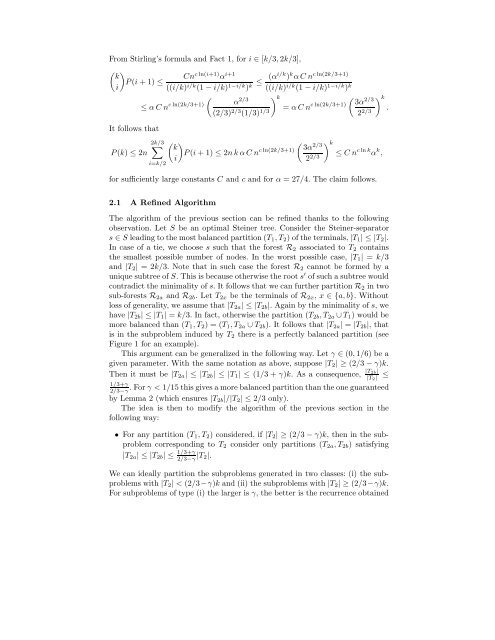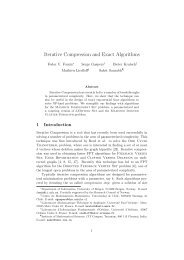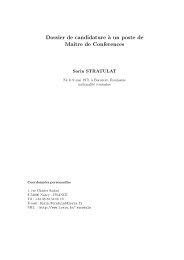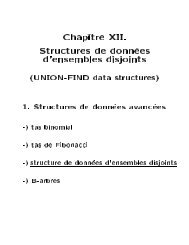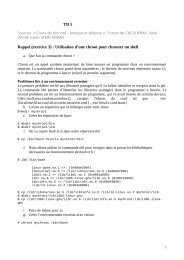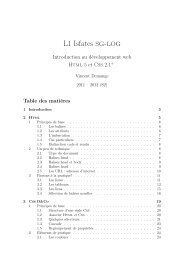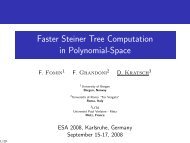Fast Steiner tree computation in polynomial space - Lita
Fast Steiner tree computation in polynomial space - Lita
Fast Steiner tree computation in polynomial space - Lita
Create successful ePaper yourself
Turn your PDF publications into a flip-book with our unique Google optimized e-Paper software.
From Stirl<strong>in</strong>g’s formula and Fact 1, for i ∈ [k/3, 2k/3],<br />
� �<br />
k<br />
Cn<br />
P (i +1)≤<br />
i<br />
c ln(i+1) αi+1 ((i/k) i/k (1 − i/k) 1−i/k ) k ≤ (αi/k ) k c ln(2k/3+1)<br />
αCn<br />
((i/k) i/k (1 − i/k) 1−i/k ) k<br />
�<br />
c ln(2k/3+1) α<br />
≤ αCn 2/3<br />
(2/3) 2/3 (1/3) 1/3<br />
�k<br />
� 2/3<br />
c ln(2k/3+1) 3α<br />
= αCn<br />
22/3 �k<br />
.<br />
It follows that<br />
P (k) ≤ 2n<br />
2k/3<br />
�<br />
i=k/2<br />
� �<br />
k<br />
c ln(2k/3+1)<br />
P (i +1)≤ 2nkαCn<br />
i<br />
� 3α 2/3<br />
2 2/3<br />
�k<br />
≤ Cn c ln k α k ,<br />
for sufficiently large constants C and c and for α =27/4. The claim follows.<br />
2.1 A Ref<strong>in</strong>ed Algorithm<br />
The algorithm of the previous section can be ref<strong>in</strong>ed thanks to the follow<strong>in</strong>g<br />
observation. Let S be an optimal <strong>Ste<strong>in</strong>er</strong> <strong>tree</strong>. Consider the <strong>Ste<strong>in</strong>er</strong>-separator<br />
s ∈ S lead<strong>in</strong>g to the most balanced partition (T1,T2)oftheterm<strong>in</strong>als,|T1| ≤|T2|.<br />
In case of a tie, we choose s such that the forest R2 associated to T2 conta<strong>in</strong>s<br />
the smallest possible number of nodes. In the worst possible case, |T1| = k/3<br />
and |T2| =2k/3. Note that <strong>in</strong> such case the forest R2 cannot be formed by a<br />
unique sub<strong>tree</strong> of S. This is because otherwise the root s ′ of such a sub<strong>tree</strong> would<br />
contradict the m<strong>in</strong>imality of s. It follows that we can further partition R2 <strong>in</strong> two<br />
sub-forests R2a and R2b. LetT2x be the term<strong>in</strong>als of R2x, x ∈{a, b}. Without<br />
loss of generality, we assume that |T2a| ≤|T2b|. Aga<strong>in</strong> by the m<strong>in</strong>imality of s, we<br />
have |T2b| ≤|T1| = k/3. In fact, otherwise the partition (T2b,T2a ∪ T1) wouldbe<br />
more balanced than (T1,T2) =(T1,T2a ∪ T2b). It follows that |T2a| = |T2b|, that<br />
is <strong>in</strong> the subproblem <strong>in</strong>duced by T2 there is a perfectly balanced partition (see<br />
Figure 1 for an example).<br />
This argument can be generalized <strong>in</strong> the follow<strong>in</strong>g way. Let γ ∈ (0, 1/6) be a<br />
given parameter. With the same notation as above, suppose |T2| ≥(2/3 − γ)k.<br />
Then it must be |T2a| ≤|T2b| ≤|T1| ≤(1/3 +γ)k. As a consequence, |T2b|<br />
|T2| ≤<br />
1/3+γ<br />
2/3−γ<br />
. For γ


